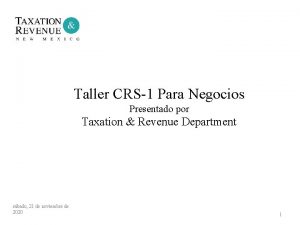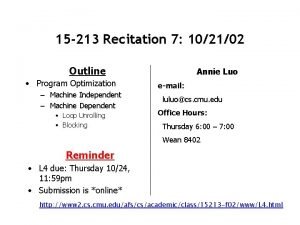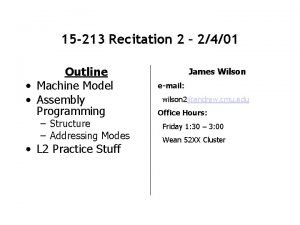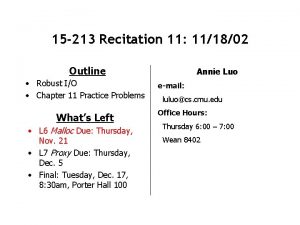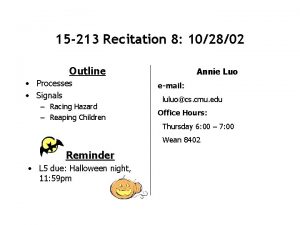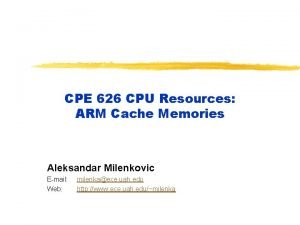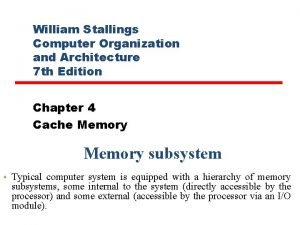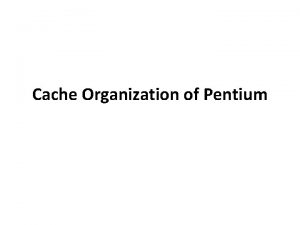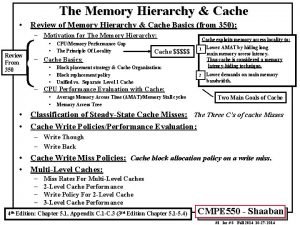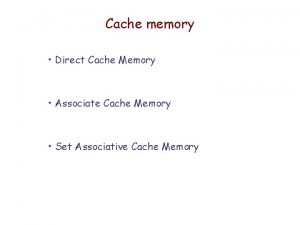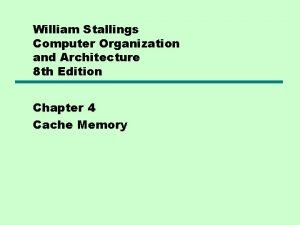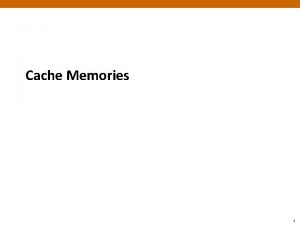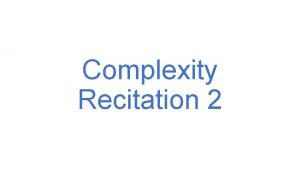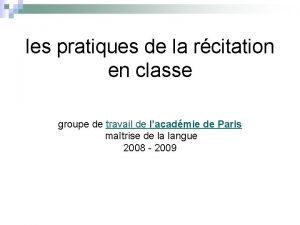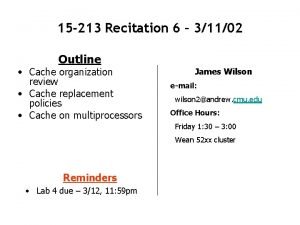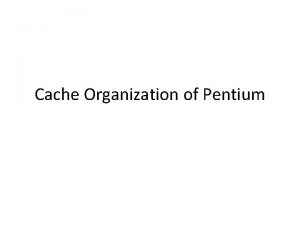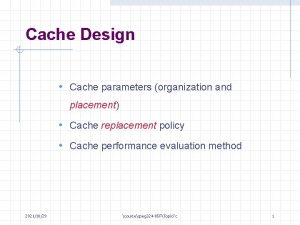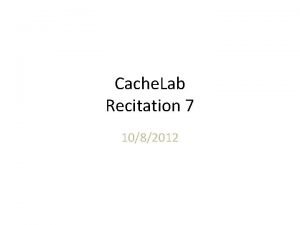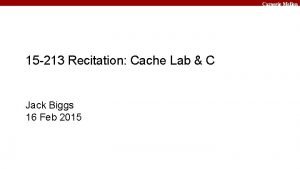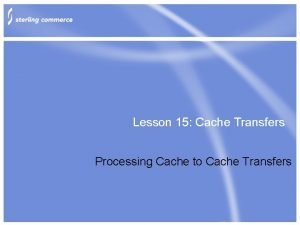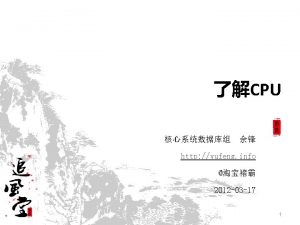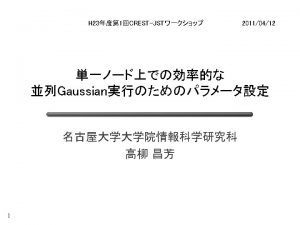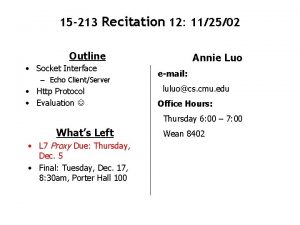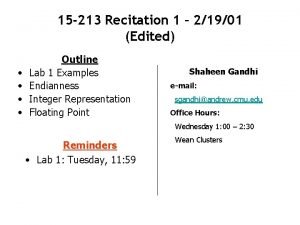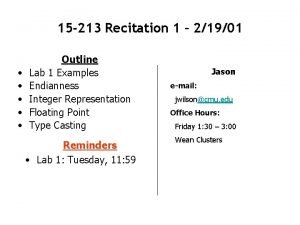15 213 Recitation 6 31102 Outline Cache Organization





















- Slides: 21

15 -213 Recitation 6 – 3/11/02 Outline • Cache Organization • Accessing Cache • Replacement Policy Mengzhi Wang e-mail: mzwang@cs. cmu. edu Office Hours: Thursday 1: 30 – 3: 00 Wean Hall 3108

Cache organization (review) Cache is an array of sets. Each set contains one or more lines. 1 valid bit t tag bits per line valid 0 1 • • • B– 1 • • • set 0: Each line holds a block of data. S = 2 s sets tag B = 2 b bytes per cache block valid tag 0 1 • • • B– 1 1 • • • B– 1 • • • set 1: valid tag 0 • • • set S-1: valid tag 0 E lines per set

Addressing the cache (review) Address A: t bits s bits b bits m-1 0 <tag> <set index> <line offset> set s: v tag 0 • • • 0 1 • • • B– 1 Address A is in the cache if its tag matches one of the valid lines in the set associated with the set index of A

Parameters of cache organization • • • B = 2 b = line size E = associativity S = 2 s = number of sets Cache size = B × E × S Other parameters: – – – s = set index b = byte offset t = tag m = address size t+s+b=m

Determining cache parameters • Suppose we are told we have a 8 KB, direct-map cache with 64 byte lines, and the word size is 32 bits. – A direct-map cache has an associativity of 1. • What are the values of t, s, and b? • • B = 2 b = 64, so b = 6 B × E × S = C = 8192 (8 KB), and we know E = 1 S = 2 s = C / B = 128, so s = 7 t = m – s – b = 32 – 6 – 7 = 19 t = 19 31 s=7 12 b=6 5 0

One more example • Suppose our cache is 16 KB, 4 -way set associative with 32 byte lines. These are the parameters to the L 1 cache of the P 3 Xeon processors used by the fish machines. • • B = 2 b = 32, so b = 5 B × E × S = C = 16384 (16 KB), and E = 4 S = 2 s = C / (E × B) = 128, so s = 7 t = m – s – b = 32 – 5 – 7 = 20 t = 20 31 s=7 11 b=5 4 0

Accessing Cache: Direct Mapped Cache Reference String 1 4 8 5 20 17 19 56 9 11 4 43 5 6 9 17 Assume Direct mapped cache, 4 four-byte lines, 6 bit addresses (t=2, s=2, b=2): Line 0 1 2 3 V Tag Byte 0 Byte 1 Byte 2 Byte 3

Direct Mapped Cache Reference String 1 4 8 5 20 17 19 56 9 11 4 43 5 6 9 17 Assume Direct mapped cache, 4 four-byte lines, Final state: Line V Tag Byte 0 Byte 1 Byte 2 Byte 3 0 1 01 16 17 18 19 1 1 00 4 5 6 7 2 1 00 8 9 10 11 3 0

Accessing Cache: Set Associative Cache Reference String 1 4 8 5 20 17 19 56 9 11 4 43 5 6 9 17 Four-way set associative, 4 sets, one-byte blocks (t=4, s=2, b=0): Set 0 1 2 3 V Tag Line 0/2 V Tag Line 1/3

Set Associative Cache Reference String 1 4 8 5 20 17 19 56 9 11 4 43 5 6 9 17 Four-way set associative, 4 sets, one-byte block, Final state: Set V Tag Line 0/2 V Tag Line 1/3 0 1 0001 4 1 0010 8 1 0101 20 1 0000 1 1 0001 5 1 0100 17 1 0010 9 2 1 0001 6 3 1 0100 19 1 0010 11 1 1010 43 1

Replacement Policy • Replacement policy: – Determines which cache line to be evicted – Matters for set-associate caches • Non-exist for direct-mapped cache

Example • Assuming a 2 -way associative cache, determine the number of misses for the following trace. A. . B. . C. . B. . A. . B. . D. . . A, B, C, D all mapped to the same set.

Ideal Case: OPTIMAL • Policy 0: OPTIMAL – Replace the cache line that is accessed furthest in the future • Properties: – Knowledge of the future – The best case scenario

Ideal Case: OPTIMAL A B C B A B D # of Misses Optimal A, + A, B+ A, C B, C+ B, C B, A+ B, A D, A+ 6

Policy 1: FIFO • Policy 1: FIFO – Replace the oldest cache line

Policy 1: FIFO A B C B A B D # of Misses Optimal A, + A, B+ A, C B, C+ B, C B, A+ B, A D, A+ FIFO A, + A, B+ C, A+ B, C+ B, C A, C+ A, B+ D, B+ 6 9

Policy 2: LRU • Policy 2: Least-Recently Used – Replace the least-recently used cache line • Properties: – Approximate the OPTIMAL policy by predicting the future behavior using the past behavior • The least-recently used cache line will not be likely to be accessed again in near future

Policy 2: LRU A B C B A B D # of Misses Optimal A, + A, B+ A, C B, C+ B, C B, A+ B, A D, A+ FIFO A, + A, B+ C, A+ B, C+ B, C A, C+ A, B+ D, B+ LRU A, + A, B+ C, A+ B, C+ B, C B, A+ B, A B, D+ 6 9 8

Reality: Pseudo LRU • Reality – LRU is hard to implement – Pseudo LRU is implemented as an approximation of LRU • Pseudo LRU – – Each cache line is equipped with a bit The bit is cleared periodically The bit is set when the cache line is accessed Evict the cache line that has the bit unset

Accessing Cache: Fully Associative Cache Reference String 1 4 8 5 20 17 19 56 9 11 4 43 5 6 9 17 Fully associative, 4 four-byte blocks (t=4, s=0, b=2): Set 0 V Tag Byte 0 Byte 1 Byte 2 Byte 3

Fully Associative Cache Reference String 1 4 8 5 20 17 19 56 9 11 4 43 5 6 9 17 Fully associative, 4 four-byte blocks (t=4, s=0, b=2): Set V Tag Byte 0 Byte 1 Byte 2 Byte 3 0 1 1010 40 41 42 43 1 0010 8 9 10 11 1 0100 16 17 18 19 1 0001 4 5 6 7 Note: Used LRU eviction policy
 Form acd31075
Form acd31075 Outline 213
Outline 213 15 213
15 213 Outline 213
Outline 213 Sigchild
Sigchild Arm cache organization
Arm cache organization Direct mapping cache organization
Direct mapping cache organization The pentium has kb instruction and kb data cache
The pentium has kb instruction and kb data cache Three level cache organization
Three level cache organization Cache memory structure
Cache memory structure Pentium 4 cache organization
Pentium 4 cache organization Cache memory organization
Cache memory organization Sajjdah
Sajjdah Recitation les machines
Recitation les machines Objectives of poem recitation
Objectives of poem recitation Rote recitation of a written message
Rote recitation of a written message Analytic rubric for poem recitation
Analytic rubric for poem recitation Tips for reciting poetry
Tips for reciting poetry 100belaud
100belaud Active recitation
Active recitation What is meant by etiquette of recitation of the holy quran
What is meant by etiquette of recitation of the holy quran Quotation sandwich
Quotation sandwich
